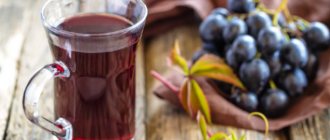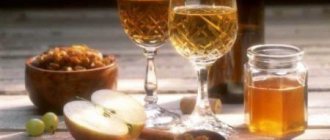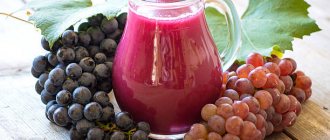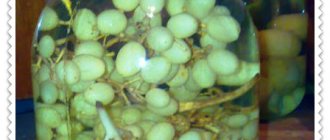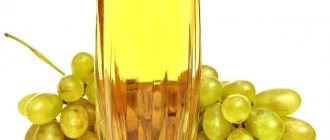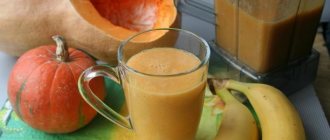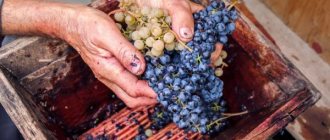How to fix wine with alcohol: calculating proportions
Those who often practice making alcohol at home ask a number of questions regarding consolidation. How to make fortified wine at home? What does it mean to fix wine and why is it done? What is used in the process and how to choose the right proportions?
How can you fortify wine?
Fortification is the addition of alcohol during or after the fermentation process. Alcohol can be fixed for several reasons, either to increase the strength of the drink or to try to prevent undesirable consequences resulting from technical errors. The second most often occurs if the temperature of wine fermentation is too high, constant access of air, which negates the work of wine yeast, resulting in the output alcohol being obtained at a very low degree.
Such a drink will not store well and may become sour. In this case consolidation is a necessary procedure to increase the strength of the wine. Fortification of wine at home can be done with the help of ethyl alcohol, good quality vodka, purified moonshine, as well as alcohol tinctures of herbs, fruits and berries. The most effective way is to add 96-degree or 94-degree alcohol.
How to properly fix wine
It is impossible to obtain stronger alcohol by fermenting the wort alone. Increasing the amount of alcohol in wine material to 12-13 percent leads to the fact that the yeast stops working and the fermentation process stops. To prepare fortified alcohol, alcoholization technology is used, which allows you to fix the wine. It comes in several types :
- alcoholization of young wine;
- alcoholization of fermenting wort on pulp.
The result of alcoholization is to stop the fermentation process . In this case, the required concentration of sugar remains in the drink and a small amount of alcohol is introduced. Each method of alcoholization has its own characteristics, which should be carefully studied in order to properly fix the drink.
Alcoholization of young wine
Before you begin to calculate the required amount of alcoholic material introduced, you should determine its actual amount in the resulting wine. This procedure can be carried out several ways .
- Determination of sugar saturation. The strength of wine primarily depends on the amount of sugar that is in the grapes themselves. The percentage of sugar in different grape varieties, which is used to calculate how many degrees there are in wine, can be found on the Internet and reference books. You should also remember that by adding 10 g of sugar to each liter of wort, you are adding 6% alcohol to it.
- Measured with an alcohol meter. The device is focused on the concentration of alcohol. An error of 1-2% is provided by dry solid particles of tartar, which are contained in wine.
- Using a hydrometer. The device measures the density of the liquid: the higher the indicator, the higher the strength of the drink.
- Distillation of distillate from a test dose. The longest, but most reliable way to measure the strength of the resulting product.
When the procedure for determining the initial strength of the wine material has been carried out, calculations should begin. How to make the correct calculation to fix wine with alcohol? To begin with, you should know that the strength increases by 1 degree if 2% vodka or 1% alcohol is added to the wine material. For example, you have 30 liters of wine material, the strength of which is 10 degrees. You need to get a drink with a strength of 15 degrees, that is, increase it by 5 degrees. In order to find out how much alcohol material is needed to fix alcohol, make the following calculations :
(30 x 1 x 5) / 100 = 150 / 100 = 1.5
If you use vodka or moonshine to fortify wine, then this formula is used here in the same way as for alcohol. Having determined how much alcohol should be added to homemade wines to strengthen them, all ingredients are thoroughly mixed and left for 15-20 days until completely assimilated. At this stage, sediment appears in the wine, and the alcohol loses its transparency.
After the combination of the alcoholic material with the wine liquid is completed, it is drained from the sediment and sent for aging. During the aging process, the drink regains its transparency and acquires its own taste and aroma. The alcohol then goes through a filtration process, bottled and hermetically sealed. - Pasteurization of wine at home - in this case it is not required . This drink is perfectly stored for a long time under any conditions, since alcohol prevents the proliferation of microorganisms.
Alcoholization of fermenting wort on pulp
When using this method of fixation , crushed fruits are added to the wort, rather than the juice squeezed from them, and sugar syrup. The closed container with the wort is left for fermentation in a room where the temperature is maintained not exceeding 26 °C. After approximately 3-5 days, the sugar concentration in the wort decreases to 6-9%.
After this, the wort itself is pressed and 90-proof alcohol is added to fix it. The prepared wort is infused for 7-8 days. Once it has infused, it is filtered, clarified, poured into closed containers and left to age for several years. Usually two years are enough, but in some cases the period is extended. The temperature during the holding period should be kept at 15 degrees.
During this period, the alcohol should be ventilated several times, saturating it with oxygen and pouring the drink from one container to another. If you follow the aging time and technology, you will get alcohol with an excellent deep taste and pleasant aroma .
Fortifying wine at home is a process in which much is learned through experimentation and personal experience. Although all the methods actually turn out to be quite simple to implement, they require a serious approach and a sufficient amount of time, as well as a great desire to get an excellent result. To fortify or not to fortify alcohol remains one of the important issues in the field of making alcohol at home .
Dilution with alcohol
The easiest way to make it is to dilute the drink with alcohol, vodka or moonshine.
To correctly select the amount of 96-proof alcohol that is used for dilution, you need to know the starting percentage, the degree of fortified wine that we want to get, and the volume of the batch that we are diluting. Increasing strength - formula:
(x*1*y):100, where
x – number of liters that need to be diluted
y is the difference between the existing and required degrees
1 – symbolizes alcohol (for convenience, it is considered 100 degrees).
If you plan to dilute alcohol with vodka, then replace 1 in the formula with 2 – (x*2*y): 100
Let's look at an example. We have 7 liters of 9-degree drink. We want to achieve a strength of 15 revolutions. Therefore, the difference between the desired and actual indicator is 6 revolutions.
Calculation for alcohol: (7*1*6):100 = 0.42 l.
Calculation for vodka: (7*2*6): 100 = 0.84 l.
Preparation according to the recipe assumes that the liquid is again left for 15-16 days for sediment to settle, after which it is drained, corked and stored. The drink can be stored for up to 2 years. The transparency of the liquid is gradually restored, and a different taste and aroma appears. This is a fairly simple recipe that is appreciated by home winemakers.
Alcoholization of wort
The production of wine must be carried out using a specific technology so that it can be fortified at the time of fermentation of the must. For this, crushed fruits are used as raw materials, and the juice from the pulp is not squeezed out. Sugar is added to the fruits in an amount of 6-9% of the volume, after which they are left to ferment for 3-4 days at a temperature of 25-26 degrees and the lid is closed.
Making wines using this recipe involves adding alcohol after this initial fermentation. Then the drink stays for another 7-8 days. At the last stage, it is filtered and placed in containers for storage and maturation. This drink can be stored for up to 2 years.
Adding sugar
How to properly fix a product with sugar during cooking? It is enough to fulfill a simple condition - 20 g of sugar per liter of drink increases the alcohol content by a degree. It will not be possible to increase the strength indefinitely in this way, since sugar inhibits fermentation.
How to make fortified wine correctly:
- for dry ones - add all the sugar in 1 dose;
- for dessert - introduce gradually on days 1, 4, 7, 10.
Freezing
Home conditions do not always suggest the possibility of using this method, but if your home is equipped with a freezer, or there is free space in the refrigerator freezer, you can try making 5-7 liters of the drink. It is necessary to pour the drink into bottles and put it in the freezer for several hours. Water freezes, but alcohol remains liquid. From 10-15 liters you can get 5-7 liters of already fortified wine.
These simple homemade recipes are easy to implement, and some of them require virtually no cost.
How to properly fix wine with alcohol
Before you fortify the wine with alcohol, you need to make an accurate calculation to get a drink with the desired alcohol concentration. We invite you to learn how to fix homemade wine with alcohol and at the same time get a homemade drink that has pleasant organoleptic properties. It is important to understand that to carry out the procedure you need to wait until the end of the fermentation and fermentation process, since strong alcohol stops these processes. In order to fix wine with ethyl alcohol, you need to measure the alcohol content in it and, based on the information received, make an accurate calculation. An example of the calculation is on this page. The material also talks about how to properly fix wine with alcohol and at the same time preserve all the taste qualities of the drink, without making it too strong.
How to fix young wine with ethyl alcohol
Wine is an alcoholic drink obtained as a result of alcoholic fermentation of fruit and berry juice. In addition to ethyl alcohol, wine contains a huge number of different substances, many of which have a fairly wide range of medicinal effects. It has been established that the therapeutic effect of the components of wine is enhanced by the presence of ethyl alcohol in it, which ensures their best absorption by the intestinal walls. Before you fix young wine with ethyl alcohol, you need to know all the technology - detailed instructions on this page will help you do everything correctly.
Calculation: how to fix wine with alcohol
When alcoholizing young wine, it is very difficult to determine the amount of alcohol added, so the calculation of how to fix the wine with alcohol is made approximately. It’s nice to think that if a wine has a strength of 10% vol. add 1% alcohol (or 2% vodka), its strength will increase by 1% vol.
For example, the strength of wine (20 l) must be increased from 10 to 15% vol., that is, by 5% vol. If you use alcohol for these purposes, you will need it: (20 x 1 x 5): 100 = 1 liter. If you take vodka instead of alcohol, then its quantity will be: (20 x 2 x 5): 100 = 2 liters.
After vodka is added to the fermented wine, it is mixed well and left for 4-5 days so that the liquids assimilate with each other.
Wine mixed with vodka becomes cloudy and sediment forms in it again. That is why it is first aged (2-3 weeks), and then removed from the sediment, filtered and only then bottled and capped.
Watch how to fix wine with alcohol in the video, which shows all the technology used at home:
How to make fortified wine at home
Fortified wine is a drink whose strength is enhanced by a stronger alcoholic drink (spirit or vodka). Typically, the strength of such wine ranges from 15 to 22 degrees. This result cannot be achieved by fermentation alone. When the alcohol level in the drink rises to 13%, the wine automatically stops fermenting. Therefore, it is customary to add alcohol or purified vodka to fortified wines. Moreover, this can be done at completely different stages. You can add alcohol to berry juice, already fermenting or young wine at the final stage of preparation.
There are different ways to mount wine. They are all different and also have some features. The fermenting wort is not squeezed out during alcoholization. Simply mash the fruits, add sugar syrup to the berry mixture and leave the bottle of wine in a warm room for further fermentation. This process can last from 3 to 5 days. During this time, the amount of sugar in the drink should drop to 7–9%. At this stage, the wort must be squeezed out, and alcohol with a strength of 90% must be added to the resulting juice. In this form, the drink should be infused for 7 days. Next, the wine is drained, clarified if necessary and bottled. It is advisable to leave the resulting young wine to mature for a couple of years. The result is a wonderful drink with a complex, pleasant taste and aroma.
The main thing in this process is to correctly calculate the amount of alcohol. Making accurate calculations can be quite difficult. It is generally accepted that to increase the strength by 1%, alcohol should be added in an amount of 1% of the volume of wine. Accordingly, you will need 2 times more vodka, that is, 2%. For example, to increase the strength of 10 liters of wine by 5%, you should add 500 ml of alcohol or 1 liter of vodka.
Important! Wine with added vodka may become cloudy over time. Therefore, the drink is first infused, and then drained from the sediment and only then bottled.
Why do you need to fortify wine?
The young drink contains two types of yeast cultures: lactic, vinegar and wine fermentation. Unfixed grape wine or other homemade drink can re-ferment during storage, turn into vinegar, and sour - lactic bacteria form mucus.
Fixing wine - preserving yeast cultures. They lose their ability to ferment. Fortified wines are homemade alcohol from 15° to 22°. Such concentration cannot be achieved with natural fermentation. At 12% alcohol content in the wort, yeast fungi enter into suspended animation.
What is fortified wine?
Fortified wine is a drink to which strong alcohol is added at various stages: vodka, alcohol, brandy and more. The name “fortified wine” originates from the times of the Soviet Union. Then this term was used to describe wines to which alcohol was added, as well as those drinks in which the degree increased directly during fermentation.
There is no reliable information about when the wine began to be distilled. But there is a version that they learned how to make a fortified drink from the moment the distillate first appeared. Since ancient times, alcohol has been added to Cahors, port, and sherry. Home winemakers also began to use the technique of fortifying the drink quite a long time ago. This is especially true for wine made from low-quality or not entirely suitable raw materials. For example, raspberries, cherries, chokeberries, black and red currants do not have enough tannins and tannins, which provide stability to the drink.
Determination of alcohol content
Before storing homemade alcohol, the density of the drink is determined to find out what percentage is alcohol. This indicator is used to calculate the proportion of ingredients introduced into wine that sterilize yeast bacteria.
There are several ways to determine the alcohol concentration: - By saturating the drink with sugar. The sugar content of berries and fruits is found on the Internet, the introduced volume is known. Based on the total amount of sugar, winemakers can easily determine the volume of alcohol. How to calculate it correctly: 10g of sugar per liter of wine is equivalent to 6% ethanol. — An alcohol meter is used for measurements. It shows the content with an error of up to 2%, the accuracy depends on the consistency of homemade alcohol. The thicker the wine, the greater the measurement error. — Using a hydrometer (or wine-sugar meter), the density of the drink is measured, and the strength is calculated from it: the value is multiplied by 0.8 (the average ratio of density and strength of table grape wines).
— The distillate distillation method involves evaporating the alcohol from a wine sample: the drink is boiled for 30 minutes and compared with the original weight of the wine portion. — A refractometer is based on the ability of a liquid to refract light. Based on the difference in the readings of the wort and the finished drink, the amount of ethanol is calculated using the tables supplied with the device.
Possible methods of fastening their advantages and disadvantages
Any of the options for preserving yeast cultures listed below are suitable for any type of homemade wine, regardless of the raw materials used for preparation. The method of fortifying with alcohol or sugar involves re-aging the drink in a dark place at 12°C for at least five days. Only then is the alcohol bottled for long-term storage.
Adding sugar
The fermentation of dry and dessert homemade alcohol is regulated during the preparation process. It is usually administered in 2–5 doses. The method allows you to achieve the desired category of drink, from dry to dessert. Details below.
How to fix wine with sugar
Depending on the type of homemade alcohol, the amount of sweetness introduced into the drink is calculated. Not only sugar is added, but also fructose. It is considered more useful. Traditional ratio of sugar in wine:
- table, strength up to 11° - from 10 to 15 g/l;
- semi-sweet, 8–13°contains from 30 to 80 g/l
- fortified, 13–16°–from 100 to 120 g/l;
- dessert, up to 15° – from 130 to 150 g.
It is important to follow the proportions and rules of winemaking:
- for dry wines, sugar is first diluted with water;
- in desserts, sweets are introduced gradually, in small portions;
- adding 1 kg of sugar increases the volume of the drink by 0.5 l;
- the amount is calculated based on the initial volume of wort.
Sugar is the main product of alcohol synthesis. If there is an excess of it, the activity of the yeast stops, so the sweetness is introduced gradually to maintain the balance of alcohol and sugar in the drink.
Alcoholization of wine (vodka, alcohol)
Fortifying wine with alcohol is simple and accessible. Ethanol is poured into the wort before standing. If a suspension forms again, you have to wait for it to fall. The sediment is removed from the drink, leaving a clean liquid that can be packaged.
What is better to use: homemade wine spirit, or to bring the drink to the desired strength with vodka, winemakers decide based on their taste. Self-sublimated alcohol contains essential plant components and has a pleasant aftertaste. How to fortify wine is described in detail below. The ratio of alcohol introduced varies for different types of homemade wine.
Freezing
Homemade drink is stabilized by concentration. The essence of the technology is simple: water turns into ice, and the strength of the remaining liquid increases. The quality of the drink does not suffer; the taste becomes richer. The technology is described below.
Pasteurization
How to fix a low gravity wine without increasing the strength and sweetness? Heating to a temperature of 70-75°C. Yeast cultures remaining in the wine will die. Heat securely sealed bottles and fill the containers to ¾ of the volume. The technology for pasteurizing wine is the same as for home-made preparations. Taste quality deteriorates slightly. Wine can be stored for years.
Adding sulfurous acid
How to fix wine at home quickly? It is enough to add preservative E220 - sulfurous acid. A table drink with a strength of up to 12-14° is stabilized with it to improve color, light wines become golden. Another plus is that pathogenic microorganisms that can destroy the drink are neutralized. They are necessarily present in the component composition of homemade wine. It is important to observe the dose; if there is an excess of sulfurous acid, the wine will become poisonous.
Fortifying wine with alcohol or vodka
Winemakers determine the volume of ethanol added per liter of drink based on the type of homemade alcohol. How much vodka is needed to fix different wines (calculated for 10 liters of drink):
- cider or apple wine is often prepared at home; it is alcoholized by introducing 1 liter per specified volume;
- for raspberry wine, half a liter is enough;
- for grape – up to 300 g.
The category of the resulting drink depends on the amount of vodka added to homemade wine. Homemade alcohol is pre-diluted to 40%; a table of concentrations is freely available.
Fortifying young wine
Add to the finished drink:
- vodka, and then the mixture is kept in an oak barrel, sherry is obtained;
- for dessert wines, vodka is added with syrup;
- for table alcohol is added to the juice before administration.
The strength of wine increases by 1% with the introduction of 2% vodka (per 10 liters 200 ml). For example, let's calculate how much vodka is needed for a 50-liter bottle: 5x200 ml = 1 liter.
Strengthening the wort during fermentation
When alcohol is added, the wine cooks faster. The wort is pressed, and then ethanol is poured in. How long does it take after this to fix the wine? At least two years. The wine undergoes a slow fermentation stage in glass or oak barrels. Ripening takes place in a cool, dark place. The result is a drink of excellent quality with a pronounced bouquet. Once every three months, it is recommended to ventilate the wine - pour it from one container to another.
How to freeze wine to increase strength
The technology is quite complex, it is important not to overfreeze the drink; ice crystals should form in it, not a block. Wine components freeze at temperatures below -8°C, water at zero. The second difficulty is straining the ice. It is convenient to pass homemade alcohol through a separator; the alcohol will not have time to fizzle out. Fortified and dessert wines are produced by freezing.
Before fixing the drink, stabilizing it before bottling, it is important to ensure that the fermentation process is complete. If no sediment forms in the bottle and there is no characteristic odor, homemade alcohol is ready. The spilled blended composition is not immediately removed to the far corner of the basement; it is allowed to stand for 5 days. Only after this, if no signs of fermentation appear in the wine, is homemade alcohol removed for storage.
Ways to increase the degree
Any of them requires careful monitoring of the drink. The liquid becomes cloudy after adding sugar or alcohol to it. It takes approximately 5 days for the components to completely mix and sediment to form at the bottom.
Before using the container, it must be thoroughly washed and only then filled with fortified wine. Next, it is best to store the bottle in a dark, cool place and monitor whether the product has begun to ferment.
- Adding sugar to the composition . In this case, before fixing the wine at home, you need to correctly calculate the amount of ingredients. The process takes quite a long time and is carried out in several stages. It is also worth considering some features. High sugar content significantly slows down the fermentation process. The drink itself should occupy no more than half the container, because 1 kilogram of sweet sand increases the volume of liquid by half a liter. To prepare dry wine, you need to add sugar diluted in water. While for making dessert, granulated sugar is added gradually. It is added in proportions of 800 grams per 10 liters to obtain sweet wine, and 400 grams to obtain semi-sweet wine.
- Alcoholization of a drink . For this type of fixation, you can use alcohol or vodka. Fortifying wine with alcohol at home is quite simple. Liquid is poured into the wort, which has been allowed to ferment for several days. Next, all the ingredients are thoroughly mixed and sent to ripen. Among the advantages of this type, it is worth noting the simplicity of the process, environmental friendliness and low cost of materials. For 10 liters of the finished product, use 1 liter of alcohol, tincture or vodka.
- The essence of this method, such as freezing, is to kill the yeast using cold. To implement it, you need a large freezer and a special centrifuge that will separate the ice. This process is quite lengthy and requires extreme care. However, it can also be done at home. The drink is poured into liter bottles and placed in the freezer for two hours. After time, the liquid freezes and the wine alcohol is drained. It is worth considering that the amount of finished liquid will decrease by about 2 times.
- In production they prefer to pasteurize the product . During the process, the drink is sealed in a vacuum space. Among the disadvantages, one should highlight the loss of taste of the finished product.
- Wine can also be fortified using sulfurous acid . This method is most often used by professional winemakers. It is generally accepted that during the process the amount of volatile acids decreases and microorganisms that harm the drink die. This method should be used with extreme caution, since large amounts of sulfur dioxide can be harmful to health. This wine is strictly contraindicated for asthmatics. In small quantities, its content in products does not in any way affect the health of the consumer.
Fortified wines
Sweet (dessert) wine products contain free (unfermented) sugar and therefore sweet drinks with a low alcohol content are not stable enough and can deteriorate during storage.
Sweet wines are strengthened by adding food alcohol or high-quality vodka. Such wines are called fortified.
The addition of alcohol eliminates the fermentation process, preserving the required amount of free sugar in the drink. To obtain some types of sweet dessert drinks (tokaj, sherry, muscat, vermouth, port), not only alcohol is added to the wine, but also sugar, various alcohol tinctures (for example, on grape skins of muscat grape varieties), aromatic components that are obtained from medicinal plants and plants with a pleasant smell.
Wines containing from 14 to 20 percent alcohol are considered fortified. Such wines can contain sugar from 5 to 16%; the acidity of such drinks is low: in the range of 0.6 - 0.8%.
How to make fortified wine at home
Fortified wine is a drink whose strength is enhanced by a stronger alcoholic drink (spirit or vodka). Typically, the strength of such wine ranges from 15 to 22 degrees. This result cannot be achieved by fermentation alone. When the alcohol level in the drink rises to 13%, the wine automatically stops fermenting. Therefore, it is customary to add alcohol or purified vodka to fortified wines. Moreover, this can be done at completely different stages. You can add alcohol to berry juice, already fermenting or young wine at the final stage of preparation.
There are different ways to mount wine. They are all different and also have some features. The fermenting wort is not squeezed out during alcoholization. Simply mash the fruits, add sugar syrup to the berry mixture and leave the bottle of wine in a warm room for further fermentation. This process can last from 3 to 5 days. During this time, the amount of sugar in the drink should drop to 7–9%. At this stage, the wort must be squeezed out, and alcohol with a strength of 90% must be added to the resulting juice. In this form, the drink should be infused for 7 days. Next, the wine is drained, clarified if necessary and bottled. It is advisable to leave the resulting young wine to mature for a couple of years. The result is a wonderful drink with a complex, pleasant taste and aroma.
The main thing in this process is to correctly calculate the amount of alcohol. Making accurate calculations can be quite difficult. It is generally accepted that to increase the strength by 1%, alcohol should be added in an amount of 1% of the volume of wine. Accordingly, you will need 2 times more vodka, that is, 2%. For example, to increase the strength of 10 liters of wine by 5%, you should add 500 ml of alcohol or 1 liter of vodka.
Before fixing homemade wine, you should understand some criteria. Each drink has its own level of sugar and alcohol content. Dessert wines have an ABV of 15 to 20% and the amount of sugar is approximately 1.2%. Liqueur wine is stronger, from 16 to 40%, sugar - 1.5%. Rose table wine contains no more than 11% alcohol and 1 to 1.5% sugar.
You should also know the proportions when adding sugar. If you add 20 grams of granulated sugar to a liter of wort, the strength will increase by 1%. But there is no need to overdo it, since too much sugar can, on the contrary, inhibit the fermentation of the drink.
Sugar is added to dry and dessert wines in different ways:
- To fix dry wines, sugar should be diluted in water and poured into the drink in one go.
- Sugar for dessert wines is dissolved in the drink itself. A small amount of granulated sugar and wine is mixed and introduced in several additions on days 1, 4, 7 and 10.
Wine alcoholization methods
The technologies for preparing fortified drinks are quite simple, so you can fortify wine at home. Almost every home winemaking recipe suggests the possibility of making fortified wine based on young wine. You can choose a recipe for quick wines that are prepared with the addition of vodka or cognac, but they should not be confused with grape infusions with vodka.
- juices (pulp);
- wort (before the start of fermentation or during active fermentation);
- finished products.
For alcoholizing wine, good vodka or pure alcohol is suitable (grape alcohol is an excellent choice). They are added in the required proportion.
Alcoholization of juice (pulp) and fermenting wort can create certain difficulties, so at home they often fortify ready-made young wine. This method is used to produce, for example, aromatic vermouths with medicinal herbs.
When alcoholizing juice or an incompletely fermented wine stock, the amount of alcohol for fixing is greater than when fixing finished wine, but there is a saving in sugar. This method is used to obtain port wine.
Fortified wine based on plain red wine
At home, you can prepare a variety of types of wine, that is, fortified wine can be white or red, it all depends directly on the choice and instructions, the recipe plays a role. The last option is the most popular. The recipe for making this drink is as follows:
- You need to take 10 kg of Isabella grapes, as well as 3 kg of sugar;
- The berries are removed from the branches, everything is very carefully cleaned of debris;
- The berries are poured into a clean container, and everything is carefully squeezed by hand;
- After squeezing out the maximum amount of juice, you will need to cover the dish with gauze and let it stand in the room for about five days.
Portion calculation
When fixing wine material, it is important to correctly calculate how much alcohol or vodka should be added to obtain a drink of the required strength.
To calculate an additional portion of alcohol, the following data is used: if you add 2% vodka or 1% alcohol to wine, the strength of which is 10 degrees, the strength of the drink will increase by 1 degree.
Let's assume that there are 15 liters of sweet strawberry wine with a strength of 10 degrees (determined by a special device - an alcohol meter). The task is to increase the strength of the drink to 14° (add 4 degrees). Vodka is used to fix it. Therefore: (15 x 2 x 4)/100= 120 /100 = 1.2 l.
Let’s say we increase the strength of the same wine by 6 degrees. We calculate: (15 x 2 x 6)/100= 180/100 = 1.8 liters of vodka. Using a similar formula, calculate how much alcohol is needed to fix the wine.
The calculated portion of alcohol is added to the wine and mixed well. For vodka/alcohol to completely combine with the wine liquid (assimilation process), at least five days must pass.
After adding vodka, the wine liquid, as a rule, becomes cloudy, and sediment falls to the bottom of the container. Fortified wine is kept in a tightly closed marinade for 15 to 20 days. After aging, it is necessary to carefully remove the liquid from the sediment. Filter, bottle, seal tightly.
There is no need to pasteurize fortified wines to increase shelf life. They are perfectly preserved for many years under any storage conditions. Alcohol prevents the development of microorganisms (yeast). Long-term storage is guaranteed for drinks with an alcohol content of more than 17 percent.
Making homemade fortified wine
You can make fortified homemade alcohol not only from grapes. Ordinary country fruits and berries are also perfect:
- apples;
- pears;
- raspberries;
- currant;
- plum;
- cherry.
We will now get acquainted with some recipes.
Cherry wine
This recipe allows you to quickly make a great drink that is sure to please everyone who tastes it.
We take:
- cherries (10 kg);
- sugar (2.5 kg);
- wine yeast (5 g);
- water (5 l).
Cut three or four fresh mint leaves from your garden, or buy some dried.
We leave the washed and squeezed berries in one pan, and pour the juice obtained from them and water into another, which we put on the fire. Add sugar and wait until it dissolves. Then add the pulp, finely chopped mint and cool the mixture to 220C. Add yeast.
Let the wort ferment for 10 days, after which we drain it from the sediment and distribute it into bottles. To make the wine stronger, add a little vodka or cognac. Then store it in the refrigerator.
From apples
Take 6 kg of apples, remove the cores, cut and crush. Place the apples in an enamel pan and leave for 3 days in a warm room. Filter the wort and squeeze out the pulp. Next, pour sugar (1.5 kg) into the juice and install a water seal.
Fermentation lasts 3 weeks. Then add another 500 g of sand. Add vodka (100 ml). After draining the liquid from the sediment, close it and put it in the basement. If a precipitate appears, filter it and put it back in the basement or refrigerator. After a few months, the drink will reach 14-160 strength. Then you can drink it.
Raspberry wine
To make it you will need:
- raspberry juice (6 l);
- water (2.6 l);
- liter of vodka;
- raspberry sourdough (300 ml);
- granulated sugar (2.4 kg).
First you need to make the starter. We get it like this: mix a couple of glasses of raspberries with half a glass of sugar and a glass of water. For 4 days, put the container in a dark place, closing it with a lid. Then filter through cheesecloth. The starter is ready.
Now we squeeze the juice out of the berries, combine the juice with the starter, 1.5 cups of sugar and water and install a water seal. Fermentation will come to an end - then it will be time to pour vodka into the mixture. Let it sit for 5 days. Then we filter, add sugar (800 g) and bottle it.
In details:
Fortified cherry wine
The cherry wine recipe is very popular among amateur winemakers. Wine, liqueurs, and liqueurs are made from cherries. Homemade cherry wine is a beautiful, tasty, aromatic drink. To store it for a long time, alcoholization of the wine product is used.
To obtain sweet homemade wine, choose sweet varieties of cherries. Cherry juice (wine preparation) is obtained from juicy ripe fruits.
Cherry pits contain a lot of tannins, so to make wine at home, only the pulp of the fruit or freshly squeezed juice is used. Fans of the tart taste and slight smell of cherry pits can crush 10–15 pits and add them at the alcoholization stage.
Making wine requires a special approach to water. It is better to give preference to spring or bottled. Wine yeast does not ferment well in tap water with a high content of chlorine and all kinds of salts, as well as in boiled water. Distilled water is not suitable for wine production.
This recipe is for 10 liters of cherry must. To prepare a homemade fortified drink you will need:
- cherry juice - 7 l;
- water - 1.6 l;
- raisins - 70 g (or wine starter);
- sugar - 2.4 kg;
- vodka - 1 l.
- Juice, water, some 1.6 kg of sugar, and unwashed raisins (or starter) are poured into the fermentation container. If the raisins are of high quality, then after three to four days the mixture should ferment.
- Fermentation will last from 10 to 12 days.
- At this stage, alcoholization is carried out: vodka is added to the wort (and cherry pits, if desired).
- Soak the wine preparation for 5 days. Filter, add the remaining sugar (0.8 kg). Stir. Pour fortified wine into bottles and seal tightly.
The recipe for making sweet wine from ripe raspberries is similar, there is a slight difference in the amount of water and juice. For 10 liters of wort you will need 6 liters of raspberry juice, 2.6 liters of high-quality water.
The result is a fortified wine of a beautiful raspberry color, with a pleasant aroma of fresh berries.
Fortified wine at home - recipe with alcohol
Let's look at how to fortify homemade cherry wine. For this we need the following ingredients:
- ripe cherry;
- special yeast starter (300 ml of starter per liter of juice);
- 96% alcohol (per liter of wine from 300 to 350 ml).
For preparation, take sweet cherries. You need to remove the seeds from it and squeeze out the juice. After this, the resulting juice is poured into a bottle and a small amount of water, granulated sugar and the prepared starter are added there. Next, the bottle should be placed in a warm place for 5 or 6 days. After this, the juice is carefully drained from the sediment and poured into a washed bottle. Now you need to pour alcohol into the container and infuse the drink in this form for about six months.
The favorite drink of many winemakers is vermouth. This wine is prepared from grapes at home. Vermouth is commonly called fortified drinks with the addition of bitter herbs. They are often used as an additive for coffee or tea. Many alcoholic cocktails are also prepared based on vermouth. Many people like to use such drinks as an aperitif, that is, to improve their appetite before eating.
Absolutely any wine can be used as a basis for making vermouth. For example, you can make a drink from one grape juice, or you can make a more complex vermouth from different berries. Rowan and cranberries are perfect for this; when combined they give a very beautiful rich color.
Let's look at one of the classic options for making vermouth. The main ingredients we need are:
- 100 ml of alcohol or 250 ml of vodka;
- four grams of medicinal yarrow;
- three grams of wormwood;
- three grams of mint;
- cinnamon stick (three grams);
- two grams of cardamom boxes;
- one gram of saffron;
- two grams of nutmeg.
Let's look at how to make fortified homemade wine from grapes and herbal tincture:
- All prepared herbs are placed in a separate glass container and filled with alcohol or vodka. The tincture must be shaken every 24 hours.
- If you don't like wormwood, you can replace it with tarragon. The amount of both the first and second ingredients remains unchanged. But you should still taste the tincture. The fact is that wormwood can have varying degrees of bitterness. It all depends on the growing conditions and the specific variety. The tincture should not be too bitter.
- When adding tincture to grape wine, it is necessary to take into account the proportions. For a liter of drink, take no more than 50 ml of tincture with alcohol or 120 ml of tincture with vodka. You should also add granulated sugar to the vermouth. For this amount of wine, 100 grams of sugar is enough. In this matter it is better to be guided by your own taste. Next, the vermouth is thoroughly mixed.
- It's time to pour the vermouth into clean glass bottles. Do not fill the container to the brim; leave half the neck empty. It will take time for the tincture to fully develop its taste and aroma. After 20–30 days, vermouth will be completely ready for consumption. You can store vermouth for a long time without spoiling.
This article showed how to determine the strength of homemade wine depending on the ingredients. We also learned how to increase alcohol content using vodka and alcohol. Wine fortification is a great way to extend the shelf life of your drink and make your homemade wine stronger. This method is suitable for a wide variety of wines. The main thing is to correctly calculate the required amount of alcohol.

